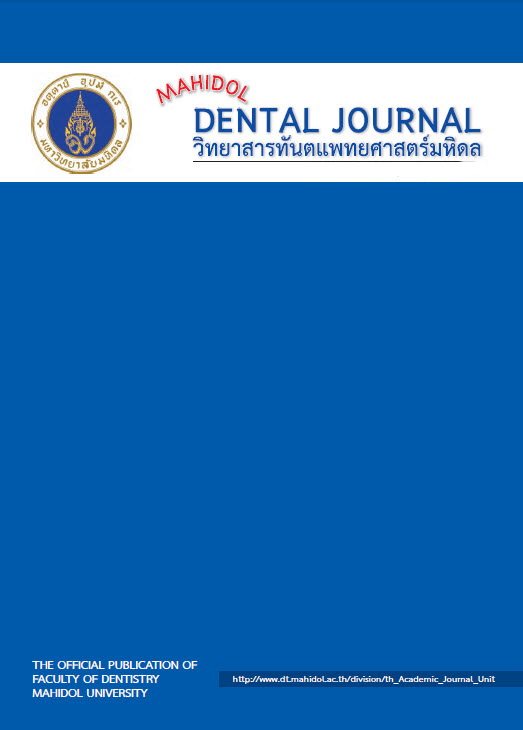Characterization of internal structural integrity of all-ceramic crowns using micro-computed tomography
Main Article Content
Abstract
Different material and fabrication technique might affect the flaw distribution in a dental restoration. The objectives of this study were to quantify the percentage volume of the existing flaws in an all-ceramic posterior restoration fabricated by heat-pressing and computer-aided design and computer-aided manufacturing (CAD-CAM) techniques.
Materials and methods: Three lithia-disilicate-based dental ceramics were used in this study (VINTAGE LD Press, IPS e.max Press and IPS e.max CAD). Ten upper first molar crowns were made for VINTAGE LD Press and IPS e.max Press as monolithic crowns using a heat-pressing technique. Ten posterior crowns were made for IPS e.max CAD using a CAD-CAM technique. Ten upper first molar substructures were also made using IPS e.max CAD and veneered with IPS e.max Ceram using a conventional condensation and sintering technique, as a control group. Micro-computed tomography (micro-CT) was used to analyze internal defects within each ceramic crown using image pixel size of 9.16 micron and a power voltage of 80 kV. The statistically significant differences between the mean percentages of closed pore for all experimental groups were analyzed using Kruskal-Wallis nonparametric test at a significance level of .05.
Results: The quantity of existing pores in an all-ceramic posterior crown was ranged between 0.0018 to 0.0482 % and Vintage LD Press and IPS e.max® CAD veneered with IPS e.max® Ceram had the highest numbers of pore compared with other monolithic restorations. All the internal pores were randomly distributed with the sizes of 36.6-256 µm.
Conclusion: The results from this study indicated that processing technique and manufacturer had an effect on the quantity and size of internal pores observed in all-ceramic restorations.
Article Details
References
2. Ding M, Henriksen SS, Martinetti R, Overgaard S. 3D perfusion bioreactor-activated porous granules on implant fixation and early bone formation in sheep. J Biomed Mater Res Part B 2016:00B:000–000.
3. An B, Li Z, Diao X, Xin H, Zhang Q, Jia X, Wu Y, Li K, Guo Y. In vitro and in vivo studies of ultrafine-grain Ti as dental implant material processed by ECAP. Mater Sci Eng 2016;C 67:34–41.
4. Boas FE, Fleischmann D. CT artifacts: Causes and reduction techniques. Imaging Med 2012; 4(2): 229-240.
5. Zhang D, Chen J, Lan G, Li M, An J, Wen X, Liu L, Deng M. The root canal morphology in mandibular first premolars: a comparative evaluation of cone-beam computed tomography
and micro-computed tomography. Clin Oral Invest DOI 10.1007/s00784-016-1852-x
6. Malkoc MA, Sevimay M, Tatar I, Celik HH. Micro-CT detection and characterization of porosity in luting cements. J Prosthodont 2015; 24: 553–561.
7. Han SH, Sadr A, Tagami J, Park SH. Non-destructive evaluation of an internal adaptation of resin composite restoration with swept-source optical coherence tomography and micro-CT. Dent Mater 2016;32(1): e1–e7.
8. Koutsoukis T, Zinelis S, Eliades G, Al-Wazzan K, Al Rifaiy M, Al Jabbari YS. Selective Laser Melting Technique of Co-Cr Dental Alloys: A Review of Structure and Properties and Comparative Analysis with Other Available Techniques. J Prosthodont 2015; 24: 303–312.
9.Tang X, Tang C, Su H, Luo H, Nakamura T, Yatani H. The effects of repeated heat-pressing on the mechanical properties and microstructure of IPS e.max Press. J Mech Behav Biomed Mater 2014;40:390–396.
10. Taskonak B, Mecholsky JJ, Jr.2, Anusavice KJ. Fracture Surface Analysis of Clinically Failed Fixed Partial Dentures J Dent Res 2006;85:277-281.
11. Suputtamongkol K, Wonglamsam A, Eiampongpaiboon T, Malla S, Anusavice KJ. Surface roughness resulting from wear of lithia-disilicate-based posterior crowns. Wear 2010;269:317–322.
12. Cheung KC, Darvell BW. Sintering of dental porcelain: effect of time and temperature on appearance and porosity. Dent Mater 2002;18:163–173.
13. Hertzberg RW. Deformation and fracture mechanics of engineering materials, 4th ed.,John Wiley & Sons, Inc., New York, U.S.A.,1995: pp 326-7.


